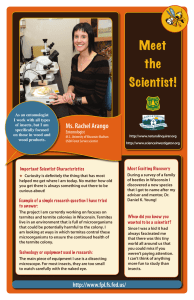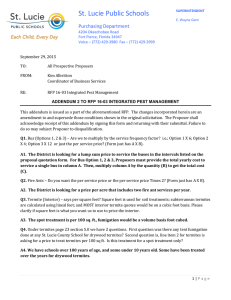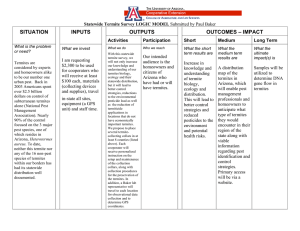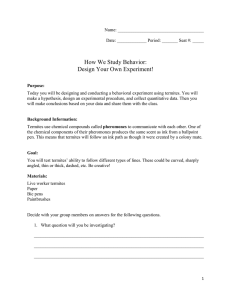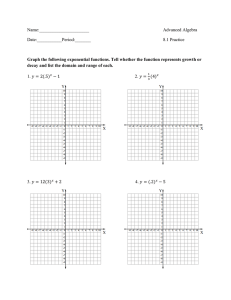Document 11232168
advertisement
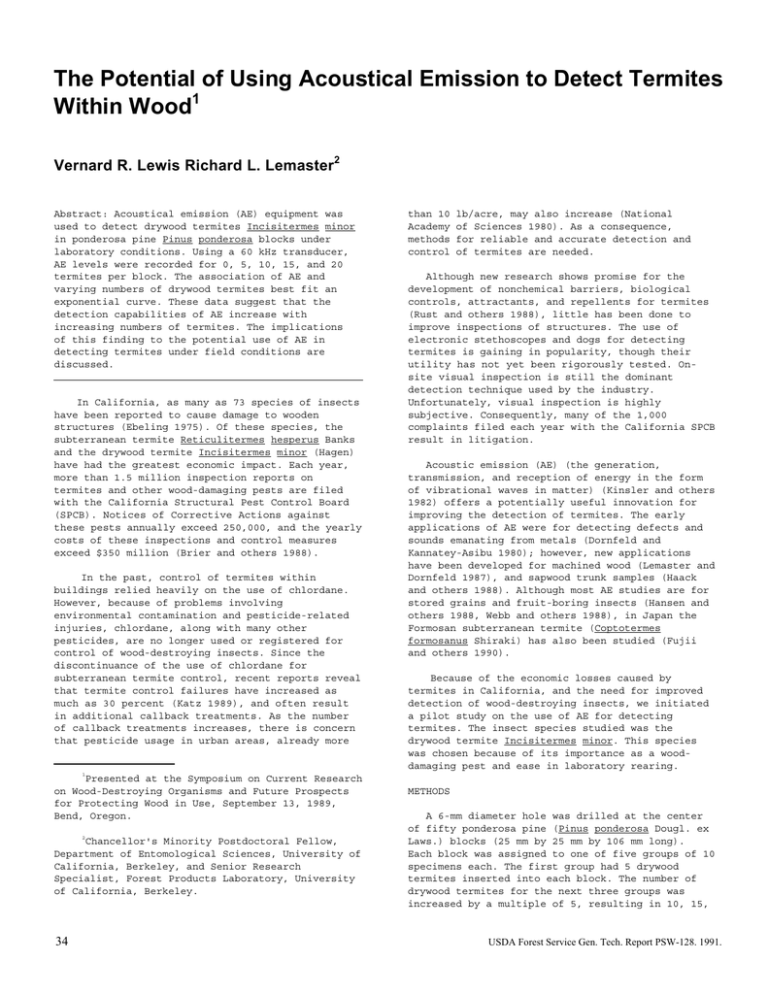
The Potential of Using Acoustical Emission to Detect Termites Within Wood1 Vernard R. Lewis Richard L. Lemaster2 Abstract: Acoustical emission (AE) equipment was used to detect drywood termites Incisitermes minor in ponderosa pine Pinus ponderosa blocks under laboratory conditions. Using a 60 kHz transducer, AE levels were recorded for 0, 5, 10, 15, and 20 termites per block. The association of AE and varying numbers of drywood termites best fit an exponential curve. These data suggest that the detection capabilities of AE increase with increasing numbers of termites. The implications of this finding to the potential use of AE in detecting termites under field conditions are discussed. In California, as many as 73 species of insects have been reported to cause damage to wooden structures (Ebeling 1975). Of these species, the subterranean termite Reticulitermes hesperus Banks and the drywood termite Incisitermes minor (Hagen) have had the greatest economic impact. Each year, more than 1.5 million inspection reports on termites and other wood-damaging pests are filed with the California Structural Pest Control Board (SPCB). Notices of Corrective Actions against these pests annually exceed 250,000, and the yearly costs of these inspections and control measures exceed $350 million (Brier and others 1988). In the past, control of termites within buildings relied heavily on the use of chlordane. However, because of problems involving environmental contamination and pesticide-related injuries, chlordane, along with many other pesticides, are no longer used or registered for control of wood-destroying insects. Since the discontinuance of the use of chlordane for subterranean termite control, recent reports reveal that termite control failures have increased as much as 30 percent (Katz 1989), and often result in additional callback treatments. As the number of callback treatments increases, there is concern that pesticide usage in urban areas, already more than 10 Academy methods control lb/acre, may also increase (National of Sciences 1980). As a consequence, for reliable and accurate detection and of termites are needed. Although new research shows promise for the development of nonchemical barriers, biological controls, attractants, and repellents for termites (Rust and others 1988), little has been done to improve inspections of structures. The use of electronic stethoscopes and dogs for detecting termites is gaining in popularity, though their utility has not yet been rigorously tested. On- site visual inspection is still the dominant detection technique used by the industry. Unfortunately, visual inspection is highly subjective. Consequently, many of the 1,000 complaints filed each year with the California SPCB result in litigation. Acoustic emission (AE) (the generation, transmission, and reception of energy in the form of vibrational waves in matter) (Kinsler and others 1982) offers a potentially useful innovation for improving the detection of termites. The early applications of AE were for detecting defects and sounds emanating from metals (Dornfeld and Kannatey-Asibu 1980); however, new applications have been developed for machined wood (Lemaster and Dornfeld 1987), and sapwood trunk samples (Haack and others 1988). Although most AE studies are for stored grains and fruit-boring insects (Hansen and others 1988, Webb and others 1988), in Japan the Formosan subterranean termite (Coptotermes formosanus Shiraki) has also been studied (Fujii and others 1990). Because of the economic losses caused by termites in California, and the need for improved detection of wood-destroying insects, we initiated a pilot study on the use of AE for detecting termites. The insect species studied was the drywood termite Incisitermes minor. This species was chosen because of its importance as a wood- damaging pest and ease in laboratory rearing. 1 Presented at the Symposium on Current Research on Wood-Destroying Organisms and Future Prospects for Protecting Wood in Use, September 13, 1989, Bend, Oregon. 2 Chancellor's Minority Postdoctoral Fellow, Department of Entomological Sciences, University of California, Berkeley, and Senior Research Specialist, Forest Products Laboratory, University of California, Berkeley. 34 METHODS A 6-mm diameter hole was drilled at the center of fifty ponderosa pine (Pinus ponderosa Dougl. ex Laws.) blocks (25 mm by 25 mm by 106 mm long). Each block was assigned to one of five groups of 10 specimens each. The first group had 5 drywood termites inserted into each block. The number of drywood termites for the next three groups was increased by a multiple of 5, resulting in 10, 15, USDA Forest Service Gen. Tech. Report PSW-128. 1991. and 20 termites per block. The last group had no termites placed in the blocks, and served as the control. Each block was inspected using an acoustic emission amplifier (100 dB) and 60 kHz transducer. The emission signals emanating from each block for two 30-second periods were recorded at a threshold voltage of 1.1 volt and were input into a computer for analysis. RESULTS As the number of drywood termites increased within sample blocks, the AE that were produced increased exponentially (fig. 1). The amount of 2 variance explained by this model was large (r = 0.77). Multiple comparisons revealed significant differences among mean AE counts and drywood termite densities (table 1; F4,97 = 5.57, p < 0.0005). Sample blocks with termites had AE counts three times greater than blocks with 5 termites, six times greater than blocks with 10 termites, three times greater than blocks with 15 termites, and approximately thirty times greater than controls. Blocks with 5, 10, and 15 termites were not significantly different from controls. DISCUSSION The use of sound vibrations to detect termites in wood is not new. Thirty-five years ago, electronic stethoscopes were first proposed to detect termites (Pence and others 1954). This technology relied on the production of audible sound waves and the ability of the human ear to perceive them. The authors claimed that this device could detect the footfall sounds of a single termite. However, widespread adaptation of this new technology did not occur, possibly because (1) only a limited band of the total sound spectrum could be utilized (e.g., sound in the non-audible frequencies is also produced by termites), (2) large differences exist in hearing ability among individuals, and (3) false readings were produced due to excessive background noise levels. More recently, workers in Japan have used AE equipment to detect Formosan subterranean termites inside wood (Fujii and others 1990). They demonstrated that AE increased as the number of termites increased; however, the type of association (e.g., linear or nonlinear) was not mentioned. The results of our analysis reveal an exponential relationship between termite number and AE. This finding suggests (1) the sensitivity of AE equipment increases exponentially with increases in drywood termite number and (2) drywood termite behavioral interactions increase exponentially with increases in termite number. However, because closed wooden blocks were used to house termites, it was impossible to tell whether the AEs recorded were derived from feeding, head-banging, walking, or background noise level. Experiments currently under way at the University of California Forest Products Laboratory utilizing a video camera, recorder, AE sensor, and wooden blocks with plexiglass fronts will allow direct observation of Figure 1-- Nonlinear regression model for mean acoustic emission (AE) counts and number of drywood termites inside ponderosa pine blocks. Vertical bars represent ± SD. USDA Forest Service Gen. Tech. Report PSW-128. 1991. 35 Table 1--Mean acoustic emission (AE) counts for five l densities of drywood termites inside ponderosa pine blocks. — 2 X AE counts (+SD)/30 sec Density 0 23.3 ( 7.5)a 5 232.1 (163.9)a 10 104.3 (128.3)a 15 184.3 ( 92.6)a 20 631.0 (405.6)b 1 Each mean is based on AE recorded twice from each of 10 pine blocks. 2 Column means not followed by the same letter are significantly different (p < 0.05, Student-Keuls-Newman [SAS 19851 multiple range test). termite behavior during AE readings. These concurrent behavioral and acoustical observations will improve the correlation of AE events and related termite behaviors, as well as outline peak AE activity periods during the day. Additional areas of study are needed and include characterizing AE from different species of insects and wood and determining the number of sensors needed to inspect large pieces of wood. These later studies will better gauge AE as a diagnostic tool for detecting wood-damaging insect pests. This information is crucial for complying with the appropriate treatment recommendations mandated by the Structural Pest Control Board Act of California. ACKNOWLEDGMENT We thank Frank C. Beall and William A. Dost for technical assistance, Richard J. Brand for statistical advice, and F.L. Kala for reviewing the manuscript. This research was supported in part by the Forest Products Laboratory, University of California, Berkeley. REFERENCES Brier, A.N.; Dost, W.A.; Wilcox, W.W. 1988. Characteristics of decay and insect attack in California homes. California Agriculture 42(5): 21-22. Dornfeld, D.A.; Kannatey-Asibu, E. 1980. Acoustic emission during orthogonal metal cutting. International Journal of Mechanical Science 22(5): 285-296. 36 Ebeling, W. 1975. Urban entomology. Berkeley: University of California Division of Agricultural Sciences; 695 p. Fujii, Y.; Noguchi, M.; Imamura, Y.; Tokoro, M. 1990. Using acoustic emission monitoring to detect termite activity in wood. Forest Products Journal 40(1): 34-36. Haack, R.A.; Blank, R.W.; Fink, F.T.; Mattson, W.J. 1988. Ultrasonic acoustical emissions from sapwood of Eastern white pine, Northern red oak, red maple, and paper birch; implications for bark- and wood-feeding insects. The Florida Entomologist 71(4): 427-440. Hansen, J.D.; Webb, J.C.; Armstrong, J.W.; Brown, S.A. 1988. Acoustical detection of Oriental fruit fly (Diptera: Tephritidae) larvae in Papaya. Journal of Economic Entomology 81(3): 963-965. Katz, H. 1989. What is the "Jugular Strategy." Pest Management 8(2): 14-15. Kinsler, L.E.; Frey, A.R.; Coppers, A.B.; Sanders, J.V. 1982. Fundamentals of acoustics, 3d ed. New York: John Wiley & Sons, Inc.; 480 p. Lemaster, R.L.; Dornfeld, D.A. 1987. Preliminary investigation of the feasibility of using acousto-ultrasonics to measure defects in lumber. Journal of Acoustic Emission 6(3): 157- 165. National Academy of Sciences. 1980. Urban pest management. Washington, D.C.: National Academy Press; 273 p. USDA Forest Service Gen. Tech. Report PSW-128. 1991. Pence, R.J.; Magasin, S.J.; Nordberg, R.G. 1954. Detecting wood-boring insects. California Agriculture 8(11): 5. SAS Institute. 1985. SAS/STAT guide for personal computers, Ver. 6 ed. Cary, North Carolina: SAS Institute, Inc.; 378 p. Rust, M.K.; Grace, J.K.; Wood, D.L.; Reierson, D.A. 1988. The search for new termite control strategies. California Agriculture 42(5): 15- 18. Webb, J.C.; Litzkow, C.A.; Slaughter, D.C. 1988. A computerized acoustical larval detection system. Applied Engineering in Agriculture 4(3): 268-274. USDA Forest Service Gen. Tech. Report PSW-128. 1991. 37
